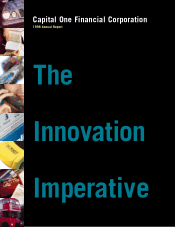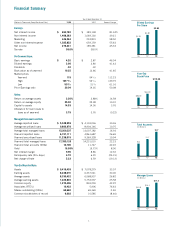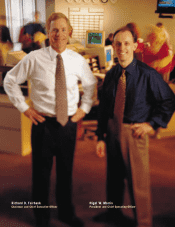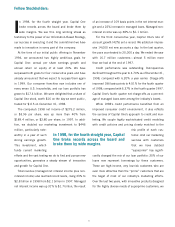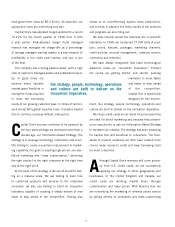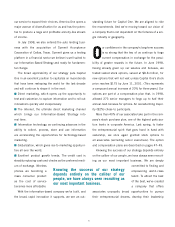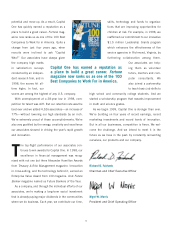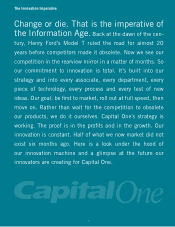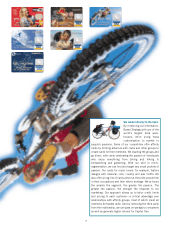Capital One 1998 Annual Report Download - page 6
Download and view the complete annual report
Please find page 6 of the 1998 Capital One annual report below. You can navigate through the pages in the report by either clicking on the pages listed below, or by using the keyword search tool below to find specific information within the annual report.
4
have grown their loans by $5.0 billion. As expected, our
superprime loans are performing very well.
Capital One’s risk-adjusted margin widened to a record
12.21% for the fourth quarter of 1998 from 9.10%
a year earlier. Risk-adjusted margin (total managed
revenue less managed net charge-offs as a percentage
of average managed earning assets) is a key measure of
profitability in the credit card industry, and ours is one
of the best.
The company has a strong balance sheet, with a high
ratio of capital to managed assets and substantial liquid-
ity. In good times our
balance sheet liquidity
creates great flexibility in
raising the funds required
to meet the borrowing
needs of our growing customer base. In times of turmoil,
such as last fall’s global liquidity crisis, it enables Capital
One to continue business without interruption.
Capital One’s success continues to be powered by
the very same strategy we developed more than a
decade ago, our Information-Based Strategy. The
strategy is to leverage technology, information and scien-
tific testing to create a quantum improvement in market-
ing capability. Our goal: to leapfrog high-priced, one-size-
fits-all marketing with “mass customization,” delivering
the right product to the right consumer at the right time
and at the right price.
At the heart of the strategy is the use of scientific test-
ing on a massive scale. We use testing to learn how
to customize products and services to the individual
consumer; we also use testing to build an innovation
laboratory capable of creating a steady stream of new
ideas to stay ahead of the competition. Testing also
allows us to cost-effectively explore many possibilities,
and to know in advance the likely results of the products
and programs we are rolling out.
We have literally turned the business into a scientific
laboratory. In 1998, we conducted 27,000 tests of prod-
ucts, prices, features, packages, marketing channels,
credit policies, account management, customer service,
collections and retention.
We have always recognized that rapid technological
advances create an “innovation imperative.” Product
life cycles are getting shorter and shorter, pushing
marketers to move faster
and faster to stay ahead
of the competition.
Capital One is specifically
designed for this environ-
ment. Our strategy, people, technology, operations and
culture are built to deliver on the innovation imperative.
We chose credit cards as our initial focus because they
are ideal for direct marketing and because they present-
ed an opportunity to use our Information-Based Strategy
to transform an industry. The strategy has been rewarding
for Capital One and beneficial to consumers. The thou-
sands of product variations we offer have created more
choice, wider access to credit and lower borrowing costs
for most consumers.
Although Capital One’s revenues still come primar-
ily from U.S. credit cards, we are successfully
applying our strategy to other geographies and
businesses. In the United Kingdom and Canada, our
credit cards are winning market share through
customization and lower prices. With America One, we
are reinventing the marketing of wireless phone service
by selling directly to consumers and mass customizing
Our strategy, people, technology, operations
and culture are built to deliver on the
innovation imperative.

